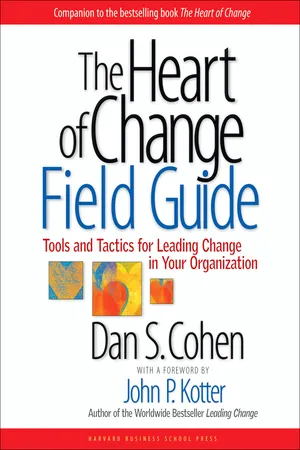
The Heart of Change Field Guide
Tools And Tactics for Leading Change in Your Organization
Dan S. Cohen
- 256 pages
- English
- ePUB (mobile friendly)
- Available on iOS & Android
The Heart of Change Field Guide
Tools And Tactics for Leading Change in Your Organization
Dan S. Cohen
About This Book
In 1996, John P. Kotter's Leading Change became a runaway best seller, outlining an eight-step program for organizational change that was embraced by executives around the world. Then, Kotter and co-author Dan Cohen's The Heart of Change introduced the revolutionary "see-feel-change" approach, which helped executives understand the crucial role of emotion in successful change efforts. Now, The Heart of Change Field Guide provides leaders and managers tools, frameworks, and advice for bringing these breakthrough change methods to life within their own organizations. Written by Dan Cohen and with a foreword by John P. Kotter, the guide provides a practical framework for implementing each step in the change process, as well as a new three-phase approach to execution: creating a climate for change, engaging and enabling the whole organization, and implementing and sustaining change. Hands-on diagnostics—including a crucial "change readiness module"—reveal the dynamics that will help or hinder success at each phase of the change process. Both flexible and scaleable, the frameworks presented in this guide can be tailored for any size or type of change initiative. Filled with practical tools, checklists, and expert commentary, this must-have guide translates the most powerful approaches available for creating successful change into concrete, actionable steps for you and your organization. Dan Cohen is the co-author, with John P. Kotter, of The Heart of Change, and a principal with Deloitte Consulting, LLC.
Frequently asked questions
Information
PART I
Climate for
Change
Table of contents
- Cover
- Copyright
- Dedication
- FOREWORD
- INTRODUCTION
- PART I: Creating a Climate for Change
- PART II: Engaging and Enabling the Whole Organization
- PART III: Implementing and Sustaining the Change
- ABOUT THE AUTHOR